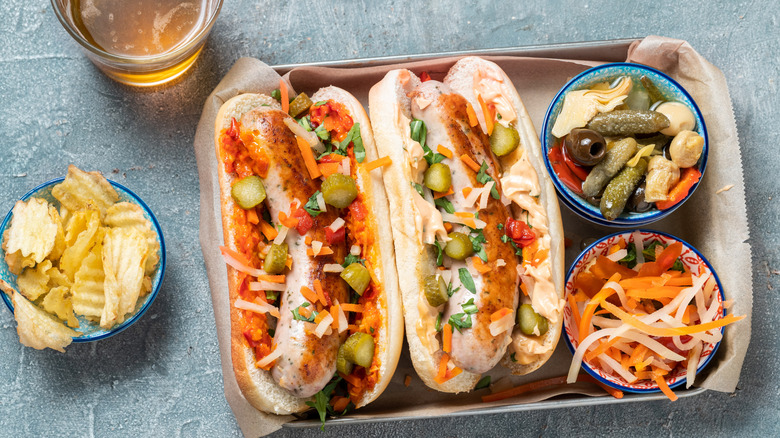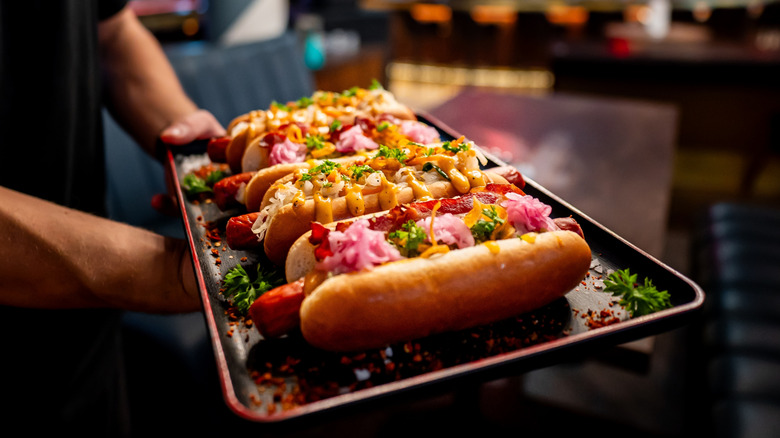Hot Dogs Vs Bratwursts: Is There Really A Difference?
At first glance, hot dogs (a baseball classic likely named after dachshunds) and bratwursts seem quite similar. Both are types of sausages, typically served snug in a bun, topped with a variety of condiments, and they're great for a cookout or baseball games. But that's where the similarities end. To find out more, Food Republic consulted with expert Nathan Gerard of Pellet Head, who explained that from ingredients, texture, and preparation methods, these two sausages have distinct identities — ones that reflect their unique history and cultural backgrounds. So yes, there are actually a few differences between the two –- quite significant ones, in fact.
Even so, the two have shared roots. Bratwursts are believed to have originated in Germany centuries ago, with the first recorded mention dating back all the way to 1313 in Nuremberg. They were introduced to America in the 19th century by German immigrants, and since then, bratwursts have gained wide popularity, especially in Wisconsin (where around 40% of the population claims German ancestry). In fact, the Wisconsin city of Sheboygan has earned the title of "Bratwurst Capital of the World."
Interestingly, hot dogs can also trace their lineage to Germany. They are descendants of traditional Frankfurter, which originated in Frankfurt in 1487, and were likewise introduced to America by German immigrants in the 19th century. It's reputed that the first person to sell frankfurters in a bun — a proto-hot dog — was a German immigrant operating a push cart in New York's Bowery in the 1860s.
What makes hot dogs unique?
According to Nathan Gerard, "Hot dogs are more processed — blended[,] smooth, cured, and packed with a milder flavor." This high level of processing is what makes hot dogs most distinct from bratwursts. The production process includes curing agents and emulsifiers, which preserve the meat and extend its shelf life. Curing agents like nitrates and nitrites are responsible for a hot dog's iconic pink hue, while blending creates a uniform, smooth texture and consistent flavor across a variety of different brands.
In terms of seasoning, hot dog meat is usually seasoned with milder spices like garlic powder, paprika, mace, and salt, resulting in a subtle taste compared to the more heavily spiced bratwurst, which incorporates traditional European spices. Hot dogs are commonly topped with relish, ketchup, or mustard, though it's not unheard of to see them served with onions, especially grilled — a similarity with bratwursts that reflects their shared German heritage.
Hot dogs are typically made from beef trimmings, and sometimes a combination of pork, beef, and chicken. Gerard noted, "Both hot dogs and brats can come in chicken [and] turkey varieties as well," and some hot dogs are 100% beef. There's a degree of versatility (including some regional variations), but not nearly as much as you can find among bratwursts. Unlike bratwursts, most hot dogs are typically sold pre-cooked and are safe to eat straight out of the package. However, some of the best ways to cook hot dogs involve the grill, braising in beer, or even using the air fryer.
What are bratwursts?
"Brats are usually made with pork or veal, seasoned with spices, and have a chunkier, more 'real meat' texture," Nathan Gerard told us. Bratwursts typically use higher-quality meats that are coarsely ground — not blended — allowing them to retain a juicier, meatier bite. Common spices in bratwursts are nutmeg, marjoram, caraway, and garlic. Bratwursts are usually sold raw at the butchers and need to be grilled, pan-fried, or boiled before eating. In true German spirit, they are often cooked in beer in Wisconsin!
Compared to hot dogs, bratwursts are considerably more versatile, reflecting a long tradition with unique regional craftsmanship. "You'll also be able to find some very unique flavors of brats at local meat markets," Gerard explained. "There is a butcher down the road from us that has over 20 flavors of brats — cheese, beer, teriyaki, spicy, peppered, and many others." While mass-produced hot dogs are less eclectic in their fillings and consistent in taste and texture, bratwursts offer much greater variety and creativity when it comes to flavors and textures. They're also far more compatible with German beer culture — think Oktoberfest — making them ideal for beer pairings. As Gerard put it, a bratwurst "gives you a lot more to experiment with when pairing with different beers than if you were just doing hot dogs."



